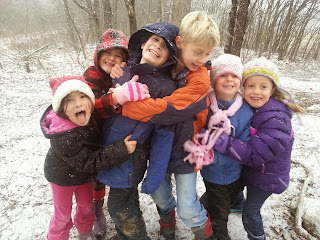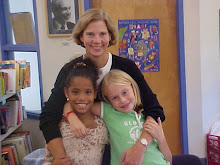Many classes are preparing for final projects this week: an 8th grade mock trial about cyber-bullying; Native American legend playlets written and performed by 4-5's; a Hudson River museum in 2-3; and a homes and habitats display of New York state animals in K-1. There is the Peace Assembly on Friday, too! Reflecting on the final preparations, teacher Lynn Schuster says in her blog Here in the 2-3's:
As we wind down our semester, the children's working days are full.
Everyone has been stretching academic muscles as essays are organized
and composed on Hudson River topics.
Confidence is tested as the children move from their research articles
into organizing and synthesizing those ideas in their own words. Patience and focus have been tested as this work
stretched over many days. As essays are finished, each child is struck
with relief, then pride and, finally, joy.
My tradition is to do a little dance with each child as he or she writes
that last word in the conclusion. Some kids love the jig. Some kids
take off and run away giggling. Jennifer and I always make sure that
their hard work is marked with a good mix of joy, humor and celebration.
Aaaah, to be with a group of smart, talented, funny and rambunctious kids each day:
that's one of my life's greatest joys.
Monday, December 16, 2013
Wednesday, December 11, 2013
What makes you happy?
K-1 teacher Liliana works with the children to create a classroom grounded in peace and friendship. To see if the children have absorbed the lessons, she asked the kids these questions: "What do you like about school?" and "What makes you happy?" Here are some of their responses (categorized after the conversation by Liliana)
Peace and Beauty
I'm so happy that the culture of our classrooms and school community is infused with these ideas. Our graduates carry it forth in their personal lives and to work in the peace corps, as doctors, educators, and as entrepreneurs for social causes. The message of peace and friendship clearly resonates - and who knows, another Nelson Mandela could be in the making.
Peace and Beauty
- Peace is a wonderful thing at school. We love people.
- In this classroom there is lots of peace and we make peace a lot.
- We help each other in a kind way. We get a lot of free choice.
- We meditate. We go into our silence.
- You can make beautiful pictures.
- You can make new friends and play. We can all play together.
- We play dress-up.
- It's a wonderful class with all these friends.
- Playing games at recess and I help my friends.
- You have really good friends and you help other people.
- We have two recesses. We can build at recess. We can build in the classroom and you can mix toys and then when we clean up we put them back where they belong. If you didn't mix the toys you could not make these structures.
I'm so happy that the culture of our classrooms and school community is infused with these ideas. Our graduates carry it forth in their personal lives and to work in the peace corps, as doctors, educators, and as entrepreneurs for social causes. The message of peace and friendship clearly resonates - and who knows, another Nelson Mandela could be in the making.
Labels:
friendship,
mindfulness,
peace,
the power of play in learning
Friday, December 6, 2013
Breathe
Taking moments throughout the day for breathing and reflecting adds to kids' ability to focus. It may even be essential for them to do well in school.
Katherine Broderick, in Why Teaching Mindfulness Benefits Students' Learning in Mind Shift, says, Learning to channel attention to productive tasks, to sustain motivation when work becomes demanding, and to handle the frustrations of sharing, learning, and communicating with peers are skills that depend on the ability to understand and manage emotions.
In preschool our students breath slowly to the diminishing sound of a chime, and in K-1, go into "their silence". 2-3's and 4-5's practice slow breaths for making transitions, and middle school students walk for 15 minutes during their daily 2000 Steps.
In Friday Assemblies we are trying something new - five calming breaths to begin and end Assembly. It gives everyone a moment to focus, it oxygenates the brain and prepares us to experience the present. A wonderful skill for life success!
Katherine Broderick, in Why Teaching Mindfulness Benefits Students' Learning in Mind Shift, says, Learning to channel attention to productive tasks, to sustain motivation when work becomes demanding, and to handle the frustrations of sharing, learning, and communicating with peers are skills that depend on the ability to understand and manage emotions.
In preschool our students breath slowly to the diminishing sound of a chime, and in K-1, go into "their silence". 2-3's and 4-5's practice slow breaths for making transitions, and middle school students walk for 15 minutes during their daily 2000 Steps.
In Friday Assemblies we are trying something new - five calming breaths to begin and end Assembly. It gives everyone a moment to focus, it oxygenates the brain and prepares us to experience the present. A wonderful skill for life success!
Thursday, December 5, 2013
A dynamic reflection
It's always great to see ourselves through someone else's eyes. Josie Holford, Head of Poughkeepsie Day School posted a reflection of her day at Parker on her terrific blog, The Compass Point. What don't you know about design thinking? Her short video tells it all!
Tuesday, December 3, 2013
Design Thinking
On Monday, Parker teachers played with a way of problem solving called design thinking. Guided by Josie Holford, the Head of Poughkeepsie Day School, we learned to frame problems in new ways in order to uncover empathy and insights that lead to innovative and creative solutions.
 Design thinking is a concept best described through work from the d.school at Stanford and IDEO. It
Design thinking is a concept best described through work from the d.school at Stanford and IDEO. It
is participatory and collaborative and turns traditional brainstorming on its head.
In one activity we broke into pairs to interview each other about our experience of using the Parker library and what problems we encounter in this highly used room. We broke our partner's response into defining words, beliefs, actions, and feelings to get at the root of the problem - to uncover their real needs and perhaps gain some surprising insights. After several rounds of clarification we each designed a solution to our partner's problem using cardboard, scrap paper, tape, scissors and pipe cleaners.
Voila! Creative solutions for a better library experience that we would not have otherwise uncovered. And of course the fun of playing with "stuff".
Educators are beginning to embrace design thinking as a way to teach students to look at problems differently - and to solve the problems of schools themselves. Already this morning Parker teachers used design thinking to help middle school kids create rules for phone use in school. Timely!
 Design thinking is a concept best described through work from the d.school at Stanford and IDEO. It
Design thinking is a concept best described through work from the d.school at Stanford and IDEO. It is participatory and collaborative and turns traditional brainstorming on its head.
In one activity we broke into pairs to interview each other about our experience of using the Parker library and what problems we encounter in this highly used room. We broke our partner's response into defining words, beliefs, actions, and feelings to get at the root of the problem - to uncover their real needs and perhaps gain some surprising insights. After several rounds of clarification we each designed a solution to our partner's problem using cardboard, scrap paper, tape, scissors and pipe cleaners.
Voila! Creative solutions for a better library experience that we would not have otherwise uncovered. And of course the fun of playing with "stuff".
Educators are beginning to embrace design thinking as a way to teach students to look at problems differently - and to solve the problems of schools themselves. Already this morning Parker teachers used design thinking to help middle school kids create rules for phone use in school. Timely!
Subscribe to:
Posts (Atom)




